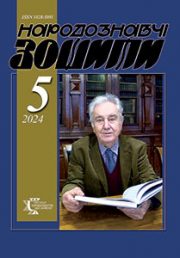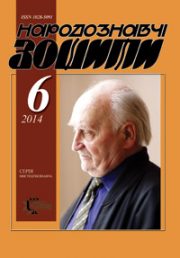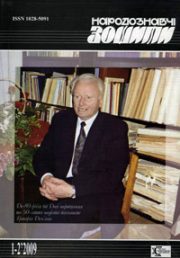The Ethnology Notebooks. 2022. № 4 (166), 885—896
UDK 930.2:[392.8 :664.6:7.011.26](=161.2)
DOI https://doi.org/10.15407/nz2022.04.885
THE STUDY SOURCE BASE OF RITUAL BREAD OF UKRAINIANS
HERUS Lyudmyla
- ORCID ID: https://orcid.org/0000-0002-5931-3816
- Doctor of Sciences in History,
- Сandidate of Аrts (Ph. D), Head of Department,
- The Institute of Ethnology of the National Academy
- of Sciences of Ukraine,
- Department of Folk Art,
- 15, Svobody Avenue, 79000, Lviv, Ukraine,
- Contacts: e-mail: ludmilagerus@gmail.com
Abstract. Introduction. The worldview fundamentals of the bread being in the traditional culture of Ukrainians are based on the awareness of the exceptionally high place of the bread in the Ukrainian cultural values hierarchy — an ethnic group with long-standing and developed experience in agriculture. The study of ritual bread creates a convincing basis for strengthening preservation and representation of existing and reviving its extinguished cultural and artistic heritage. Of particular importance for scientific research is the outline and analysis of the declared problem or topic source base.
The article purpose is the comprehensive coverage of the source base to study the ritual bread of Ukrainians. To achieve the goal, it is necessary to solve the following research tasks: to identify and characterize the main groups of sources, and to show their importance for a thorough disclosure of the issue. The object of research is a process of historical thought development, as well as the researchers` works the main subject of which consists in the study of rituals and customs of Ukrainians, the subject — the sources array which accumulates optimal information about the ritual bread of Ukrainians.
Bibliographical methods for collecting information and its theoretical analysis, systematization, and generalization were used.
Conclusion. A chronological review of the sources shows the dynamics of interest in collecting and studying materials about the functioning of bread in the rituals of Ukrainians among local historians, ethnologists, historians, cultural experts, and art historians. A significant volume of found sources makes it possible to specify the bread spread territorial in general and its individual types in the ritual practices of Ukrainians, to identify their local variants. The identified and analyzed source array of materials, different in origins and information potential, necessary for the ritual bread study, can be divided into verbal (printed, handwritten, oral), visual (artifacts, works of painting and graphics, photographs), and behavioral (making process, application) groups.
Keywords: ritual bread, source base, artifact, heritage, museum, culture.
Received 1.09.2022
REFERENCES
- Herus, L. (2022). Ukrainian Ritual Bread: Ethnocultural Specifics of the Visual Image. Revista de Etnologie si Culturologie (Vol. XXXI, рр. 107—115). DOI: https://doi.org/10.52603/rec.2022.31.12 [in Russian].
- Fradkin, V.Z. (1993). To the history of creation and activity of the ethnographic museum KhHPhS. Collection of the Kharkiv Historical and Philological Society (Vol. 1, pp. 5—14) [in Ukranian].
- Markevich, O. (1903). Kharkiv Archaeological Congress. Notes of the Shevchenko Scientific Society (Vol. LIII, book 3, рр. 1—18) [in Ukranian].
- Dankovska, R.S. (1925). History of the Ethnographic Department named after Needs and book collections of the Museum of Slobodsk Ukraine. Museum of Slobodsk Ukraine. Bulletin (Part 4, рр. 16—18). Kharkiv [in Ukranian].
- Letter-appeal from the Board of the NTSH to teachers in the matter of collecting Easter eggs. Central State Historical Archive of Ukraine in Lviv. F. 309. Op. 1. Od. save 70. Arс. 38 [in Ukrainian].
- (1913). Management of the Museum of the Scientific Society named after Shevchenko. From the Museum of the Shevchenko Scientific Society. Illustrated Ukraine, 8, 11 [in Ukrainian].
- (1914). Easter eggs. Work, 84, 3 [in Ukrainian].
- Temporary catalog of the Ukrainian National Museum at the Scientific Society. Shevchenko in Lviv. Departments of archeology and ethnography. Lviv [in Ukrainian].
- Ewgen, Спб. (1913). The Ukrainian department at the second All-Russian craft exhibition in St. Petersburg in 1913. Illustrated Ukraine, 11, 5 [in Ukrainian].
- (1983). Ukrainians of the XIX—XX centuries: Catalog-index of ethnographic collections. Leningrad [in Russian].
- Zahlada, N. (1931). Food in the village Starosillia in Chernihiv region. Materiialy do ethnolohii (Vol. 3, pp. 83—196) [in Ukrainian].
- Kulchytska, O. (1944—1953). Drawings of exhibits of the Museum of Ethnography and Crafts. Archive of the Institute of Ethnology of the National Academy of Sciences of Ukraine. F. 3. Od. save 2. Arc. 1—102 [in Ukrainian].
- Herus, L. (2001). Folk toy, ceremonial cookies in the drawings of Olena Kulchytska. The Ethnology notebooks, 1, 175—180 [in Ukrainian].
- Kolberg, O. (1882). Pokucie. Ethnographic image: in 4th part (Vol. 1). Krakow: Printing House of the Jagiellonian University [in Polish].
- Shukhevych, V. (1899). Hutsulschyna. Materialy z ukrains’ko-rus’koi etnolohii (Vol. II, part 1, pp. 1—144) [in Ukrainian].
- Shukhevych, V. (1902). Hutsulschyna. Materialy z ukrains’koru-s’koi etnolohii (Vol. V, part III, pp. 1—255) [in Ukrainian].
- Shukhevych, V. (1904). Hutsulschyna. Materialy z ukrains’ko-rus’koi etnolohii (Vol. VII, part 4, pp. 1—272) [in Ukra inian].
- Lytvynova-Bartosh, P. (1900). Wedding rites and customs in the village of Zemlyantsi, Glukhiv district, Chernihiv region. Materialy z ukrains’korus’koi etnolohii (Vol. III, pp. 70—172) [in Ukrainian].
- Sumtsov, M.F. (1918). Slobozhane: historical and ethnographic research. Kharkiv [in Ukrainian].
- Dankovskaya, R. (1909). Little Russian ritual cookies of Kursk governorate. Ethnographic Review, 1 (book LXXX, pp. 21—34) [in Russian].
- Dankivska, R. (1925). Folk ceremonial cookies «Nuts» (About the collection «Nuts» in the Kharkiv Museum of Sloboda Ukraine named after G.S. Skovoroda). Notes of the Ethnographic Society (Book 1, pp. 27—33) [in Ukranian].
- Dankovska, R.S. (1926). Ethnographic study of Ukrainian ritual cookies. Scientific collection of the Kharkiv Research Department of the History of Ukrainian Culture (Vol. 2—3, pp. 199—208). Kharkiv [in Ukranian]
- Dworakowski, S. (1939). Wedding ceremonies in Niemowicze (Sarnenski poviat). Yearbook of Wolynski (Vol. 8, pp. 280—305). Rowne [in Polish].
- Filipowicz, K. (1939). Wedding bread in the Lubomelski poviat. Yearbook of Wolynski (Vol. 8, pp. 280—305). Rowne [in Polish].
- Zham, O. (2009). The Museum of Bread of the National Historical and Ethnographic Reserve «Pereyaslav»: to the 25th anniversary of its creation and activity. Local history, 1—2, 135—142) [in Ukrainian].
- Panchuk, M.V., Nedaiborshch, T.A., & Tsvetkova, A.M. (2020). The People’s Museum of Bread in the village of Bilopylla in the Vinnytsia region is a living history of the agricultural region Museum affairs in the Zhytomyr region: history and modernity. Scientific collection «Greater Volyn». Materials of the All-Ukrainian Scientific Regional History Conference (Vol. 60, pp. 99—105). Berdychiv [in Ukrainian].
- The Museum of Bread has appeared in Odessa. Retrieved from: http://prostir.museum/ua/post/6886 (Last accessed: 18.08.2022) [in Ukrainian].
- The Museum of Bread. Retrieved from: http://nashyarmarok.org.ua/vsi-kategoriji/entry/5-muzej-khliba (Last accessed: 18.08.2022) [in Ukrainian].
- The Museum of Bread was opened on April 21, 1983. Retrieved from: http://sch17.kharkivosvita.net.ua/document/38 (Last accessed: 18.08.2022) [in Ukrainian].
- The Museum of Bread. Retrieved from: http://www.adm-pl.gov.ua/old/kotelev/3918.htm (Last accessed: 18.08.2022) [in Ukrainian].
- Vasylevsky, Mykhailo. (2003). The Museum of Bread in the village was opened. Day, 233. Retrieved from: http://www.day.kiev.ua/uk/article/den-ukrayini/vidkrito-muzey-hliba-v-seli (Last accessed: 18.08.2022) [in Ukrainian].
- Herus, L. (2021). «Svetlitsa of bread» of the School Museum of the History of the village of Pogorilyvka: Experience of Preservation, Revival and Popularization of Intangible Cultural Heritage. Artistic culture: history, theory, methodology: reports. and messages. IX International scientific conferences (Pp. 11—17). Lviv [in Ukrainian].
- The Museum of Bread has appeared in Kyiv. Retrieved from: http://ua.comments.ua/life/165279-u-kiievi-zyavivsya-muzey-hliba.html (Last accessed: 18.08.2022) [in Ukrainian].
- Liposhko, Olena. The Museum of Bread was opened near Kremenchuk. Retrieved from: http://vestnik.in.ua/news/culture/1551-pd-kremenchukom-vdkrili-muzey-hlba.htm (Last accessed: 18.08.2022) [in Ukrainian].
- Herus, L. (1999—2006). Ceremonial bread (Zhytomyr region, Ternopil region, Lviv region). Materials of field researches L. Herus. Archive of the Institute of Ethnology of the National Academy of Sciences of Ukraine. F. 1. Op. 2. Od. save 338-3. Arc. 1—15; Od. save 338-4. Arc. 1—10; Od. save 338-5. Arc. 1—11 [in Ukrainian].
- Herus, L. (2008). Ceremonial bread (Vyzhnytskyi, Putilskyi districts of Chernivtsi region, Verkhovynskyi districts of Ivano-Frankivsk region, village Pohorilivka, Zastanivsky district, Chernivtsi region). Materials of field researches L. Herus. Archive of the Institute of Ethnology of the National Academy of Sciences of Ukraine. F. 1. Op. 2. Od. save 581. Arc. 1—11 [in Ukrainian].
- Herus, L. (2009). Ceremonial bread (Volovetskyi, Mizhhirskyi districts of the Transcarpathian region). Materials of field researches L. Herus. Archive of the Institute of Ethnology of the National Academy of Sciences of Ukraine. F. 1. Op. 2. Od. save 596 б. Arc. 1—105 [in Ukrainian].
- Herus, L. (2010). Ceremonial bread (Kostopilskyi, Bereznivskyi, Sarnenskyi districts of the Rivne region). Materials of field researches L. Herus. Archive of the Institute of Ethnology of the National Academy of Sciences of Ukraine. F. 1. Op. 2. Od. save 599 а. Arc. 1—58 [in Ukrainian].
- Herus, L. (2014). Ceremonial bread (Tlumatskyi, Tysmenetskii, Horodenkivskyi, districts of Ivano-Frankivsk region). Materials of field researches L. Herus. Archive of the Institute of Ethnology of the National Academy of Sciences of Ukraine. F. 1. Op. 2. Od. save 767. Arc. 1—60 [in Ukrainian].
- Herus, L. (2015). Ceremonial bread (Snyatinsky, Horodenkivskyi districts of Ivano-Frankivsk region, Kitsmanskyi district of Chernivtsi region). Materials of field researches L. Herus. Archive of the Institute of Ethnology of the National Academy of Sciences of Ukraine. F. 1. Op. 2. Od. save 772. Arc. 1—39 [in Ukrainian].
- Herus, L. (2016). Ceremonial bread (Horodenkiv district, Ivano-Frankivsk region). Materials of field researches L. Herus. Archive of the Institute of Ethnology of the National Academy of Sciences of Ukraine. F. 1. Op. 2. Od. save 772. Arc. 1—52 [in Ukrainian].
- Herus, L. (2020). Preservationofthe intangible cultural heritage: ukrainian experience. The Ethnology notebooks,, 1 (151), 3—14. Retrieved from: https://nz.lviv.ua/archiv/2020-1/3.pdf DOI https://doi.org/10.15407/nz2020.01.003 [in Ukrainian].
- Herus, L. (2022). Cultural and artistic space of «Holiday of Bread» festival: concept, functions. The Ethnology notebooks,, 1 (163), 218—225. Retrieved from: https://nz.lviv.ua/2022-1-23/ DOI https://doi.org/10.15407/nz2022.01.218 [in Ukrainian].







